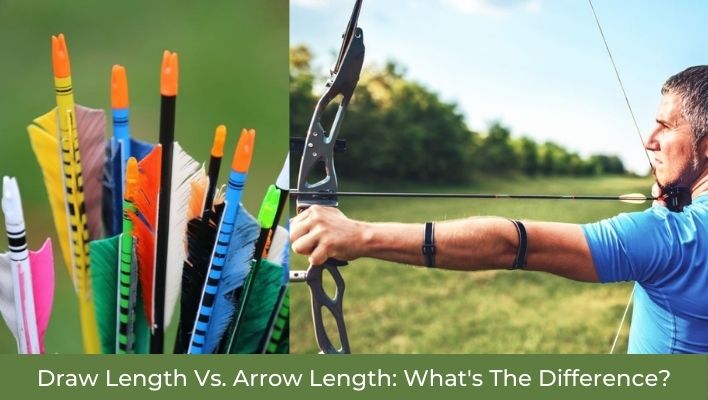Draw length and arrow length aren’t equal. Each signifies different things, and most importantly, they determine your archery performance.
Today, we’ll bring an end to the draw length vs. arrow length debate.
The primary difference between draw length and arrow length is the way these two measurements are taken. Draw length is the distance from the deepest grip of the throat to the nock point, plus 1.75″ at full draw. On the other hand, arrow length refers to the distance of the arrow shaft. Arrow length is determined based on draw length.
But this isn’t the conclusion. Numerous other factors come into play. Let’s explore them.
Table of Contents
- What Is Draw Length?
- What Is Arrow Length?
- Arrow length vs. arrow size: What are the differences?
- Can Draw Length Change over time?
- Are Longer Or Shorter Arrows better?
- How does Draw Length Affects Arrow Speed?
- Is there any relationship between draw length and draw weight?
- Conclusion
- FAQs
What Is Draw Length?
Draw length is the measurement of the full draw of your bow. It is generally measured from the grip point to the anchor point, although other methods of measurement exist. Furthermore, the process of determination varies from bow to bow.
Click here to learn more about how to measure draw length.
Each type of bow possesses its unique draw length. For example, the draw length of a compound bow will differ from that of a recurve bow.
Conventional bows encompass a wider possible range of draw lengths, unlike compound bows, which have limitations due to their specific design.
Another essential point to understand is that draw length won’t be uniform for everyone even if they have the same type of bow. This implies that draw length varies from person to person.
What Is Arrow Length?
Arrow length represents the distance of the arrow shaft and is determined from the back of the arrow to the broadhead.
Discovering the correct arrow length can be a bit perplexing at first glance, mainly due to the distinction between arrow length and arrow sizes (more on this in the following section).
Arrow length stands as a significant metric in relation to an archer’s achievement.
Why is this the case?
Because an inaccurate arrow length results in imperfect, less potent, and less forgiving shots.
When an arrow is too short, it might pose potential safety hazards such as the risk of “arrow through hand,” leading to tearing injuries.
Thus, identifying an appropriate arrow length is not only pivotal for precise shooting but also for ensuring your safety. There exist a couple of methods to measure this. Find out more about how to measure arrow length.
Arrow length vs. arrow size: What are the differences?
So, what distinguishes arrow length from arrow size? What has led to the confusion?
Actually, not much. There exists a clear distinction between arrow length and arrow size. However, the terms “length” and “size” are often mixed up, especially among beginners.
Let’s clarify.
Arrow length denotes the overall distance of the arrow shaft.
On the other hand, arrow size pertains to the stiffness of an arrow’s spine. But what does stiffness indicate in terms of an arrow spine?
Stiffness measures how rigid an arrow’s spine is and to what extent it can prevent flexing.
Now, let’s delve into the factors that determine arrow spines:
- Arrow length
- Arrow weight
- Point weight
Can Draw Length Change over time?
Yes, draw length can indeed undergo changes over time.
Why does this happen?
The answer encompasses two aspects.
Firstly, your draw length might vary depending on the type of bow you’re using. Different types of bows entail different draw lengths. Moreover, your draw length can alter during periods of growth or when recuperating from significant injuries. On the flip side, another query might arise: “Can I modify my draw length?”
The response is affirmative. If you possess an adjustable bow, you have the ability to modify your draw length.
Are Longer Or Shorter Arrows better?
The answer is subjective.
Determining whether shorter or longer arrows are better depends on personal preference.
In greater detail, the answer can be viewed from two perspectives.
- The answer encompasses two aspects. One pertains to safety, and the other concerns speed. Shorter arrows can be hazardous and result in severe injuries such as “arrows through the hand.” Moving on to the second aspect, we have the influence of arrow length. The stiffness of an arrow is affected by its length. More robust bows demand stiffer arrows due to the archer’s paradox. Ideally, an arrow should possess a lengthy yet precisely measured length, devoid of any unnecessary excess.
- Shorter arrows, being lighter, will be propelled faster from the bow. Conversely, longer arrows, despite their weightiness, maintain arrow velocity, thereby facilitating accurate shots.
How does Draw Length Affects Arrow Speed?
This question prompts a swift summary of the draw length’s definition.
Once more, draw length refers to the extent of your bow’s draw at full length.
Upon pulling back your bow, it accumulates potential energy, subsequently propelling the arrow upon release.
Consequently, if you only partially draw your bow, it won’t amass the same potential energy as a full draw.
With diminished potential energy, the arrow speed also decreases.
It follows, then, that arrow speed and draw length are directly interconnected.
The ideal arrow length furnishes ample strength, thus augmenting its forgiveness and, naturally, ensuring precise shooting.
Do shorter (or longer) arrows fly faster?
Generally, shorter arrows are lighter than longer arrows. Therefore, short arrows fly faster than long arrows.
Additionally, shorter arrows are frequently stiffer than longer ones, which imparts higher speed to the arrow. (I elaborated on the technical details about this in the preceding sections.)
However, short arrows are not as inherently stable as long arrows. To attain comparable stability, short arrows necessitate a greater Forward of Center (FOC). If the term FOC in archery is unfamiliar to you, you can find more information in this article.
Is there any relationship between draw length and draw weight?
First, let’s clarify the concept of draw weight.
In simple terms, draw weight refers to the force required to pull the string back to its anchor points. You might have encountered the term, such as a “45-pound bow.” As archers, when we refer to a 45-pound bow, it indicates that we need to exert 40 pounds of force to draw the bow back to the anchor point.
Furthermore, you are already familiar with draw length.
Draw length denotes the measurement from the anchor point to the grip point.
Nonetheless, there isn’t a direct correlation between draw length and draw weight.
Draw length remains fixed and individual-specific.
Yet, is there no connection at all?
Indeed, there is.
How?
Let’s imagine you have a bow that is too powerful for you (over-bowed). In such cases, drawing your bow to its full length becomes notably challenging, potentially leading to an elevated bow position.
So, here’s the insight:
As the draw weight increases, your capacity to draw the bow back to its full length decreases.
Conclusion
Hopefully, we’ve managed to alleviate at least some of your confusion regarding the distinction between Draw Length and Arrow Length.
Should you have any further questions on this matter, please don’t hesitate to leave a comment, and we’ll promptly provide you with an answer.
FAQs
How much longer should arrow be than draw length?
As a general rule of thumb, your arrows should be 1 or 2 inches longer.
Is draw length the same as arrow length?
No, draw length, and arrow length aren’t the same. Draw length is the length of the full draw of your bow.
Can an arrow be too long?
No, your arrows should be too long or too short.
How heavy should my arrow be?
Your arrows shouldn’t be too heavy or too light. Either way has its own disadvantages.
What is the average length of an arrow?
The average arrow length is 30 inches.
How do I make my draw length longer?
Get an adjustable bow to make the draw length longer.
Does a release change draw length?
No. the thumb release doesn’t change draw length.


